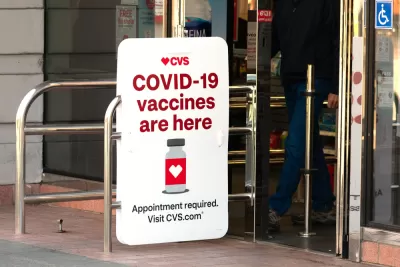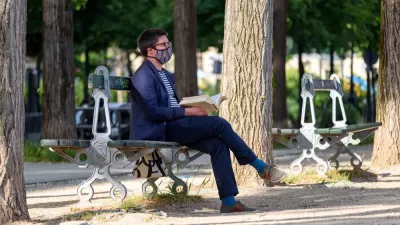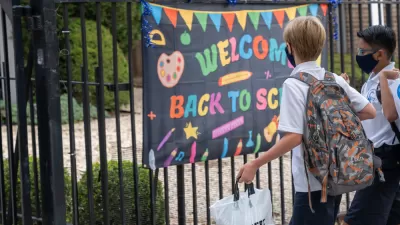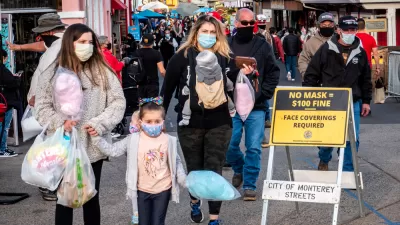The CDC abruptly changed its masking guidance on May 13 to further distinguish behavior for those who are fully vaccinated from those who are not, prompting states, counties and businesses to end indoor mask mandates and social distancing.

[Updated May 17, 2021]
[Contributor's note: The title comes from a dialog between CNN anchor Jake Tapper and CNN chief medical correspondent, Dr. Sanjay Gupta, on May 14: "People who are not vaccinated like your [11-year-old] son are going to be more at risk, said Gupta. "But also, unvaccinated people subsequently spreading it to other unvaccinated people this, virus. It just could prolong this pandemic..."].
Speaking from the White House Rose Garden last Thursday, President Joe Biden addressed the American public on the pandemic milestone:
"Well, today is a great day for America in our long battle with the coronavirus.
"Just a few hours ago, the Centers for Disease Control and Prevention — the CDC — announced that they are no longer recommending that fully vaccinated people need wear masks. This recommendation holds true whether you are inside or outside."
The president was referring to a press briefing held by the White House COVID-19 Response Team on May 13 during which CDC Director Rochelle Walensky provided an update regarding CDC’s guidance for fully vaccinated people that, in addition to ending masking, included an end to the need for social distancing for those who are two weeks past their second dose of the Pfizer or Moderna COVID-19 vaccines or two weeks beyond one dose of the Johnson & Johnson Covid-19 vaccine.
CDC: Summary of Recent Changes – Updates as of May 13, 2021 [italics added]
- [F]ully vaccinated people no longer need to wear a mask or physically distance in any setting, except where required by federal, state, local, tribal, or territorial laws, rules, and regulations, including local business and workplace guidance.
- CDC prevention measures continue to apply to all travelers, including those who are vaccinated. All travelers are required to wear a mask on all planes, buses, trains, and other forms of public transportation traveling into, within, or out of the United States and in U.S. transportation hubs such as airports and stations. [See Ian Duncan's piece in The Washington Post: "Masks are still required in planes, trains and buses despite the loosened CDC guidelines."]
- At this time, there are limited data on vaccine protection in people who are immunocompromised, so they should discuss the need for personal protective measures with their healthcare provider after vaccination.
Abrupt about-face
What caught many public experts by surprise was the suddenness of the announcement, coming a mere 16 days after CDC had revised masking guidance for outdoor activities (see April 27 press briefing by White House Covid-19 Response Team).
"The CDC has gone from one extreme to the other, from over-caution to throwing caution to the wind," wrote Dr. Leana S. Wen, a CNN medical analyst and former Baltimore health commissioner in a critical opinion in The Washington Post on May 14.
Why the change?
Walensky began her May 13 presentation [view here] with an encouraging update on COVID metrics: cases, hospitalizations and deaths continued to decline. Gone was her "feeling of impending doom" expressed just over six weeks ago at a press briefing by the Covid team on March 29. After describing a $7.4 billion investment in public health infrastructure funded by the American Rescue Plan, Walensky provided the three data-based scientific reasons why the CDC has chosen to revise the masking and social distancing guidance for those who are fully vaccinated.
- We now have numerous reports in the literature that demonstrate the safety and real-world effectiveness of the authorized vaccines. On this slide, there are three recently published studies — one from Israel published in the Journal of the American Medical Association, or JAMA, on the top, and two from the United States, both published in CDC’s Morbidity and Mortality Weekly Report [March 29/April 2 and April 28/May 7 — which all show that COVID-19 vaccines work.
- Additionally, we are accumulating data that our authorized vaccines are effective against the variants that are circulating in this country.
- Finally, we know that in the rare event that people get infected after a vaccine, the resulting infection is more likely to have a lower viral load, be shorter in duration, and likely less risky of transmission to others. [See CNN, May 14: "New York Yankees say 8 vaccinated members tested positive for Covid-19."]
On May 14, CDC released additional scientific evidence showing that the two authorized mRNA vaccines "reduced the risk of getting sick with COVID-19 by 94% among health care personnel who were fully vaccinated."
Appearing on CBS This Morning on May 14, Walensky gave two additional reasons for the sudden revision [see video and transcript via Yahoo! News]:
- "[I]n the last two weeks, our cases have come down by a third. [The New York Times coronavirus database indicates that the 7-day rolling average of new reported cases on May 13 was almost 35,500, a decrease of 31% over the last two weeks]. So we have a rapidly declining case rate probably because our vaccination rate is going up.
- "Second, because we now have vaccines that are widely available to anybody who wants it. If you text your zip code to 438829, you can find one of many vaccine sites that are near you."
In response to a question asked by co-host Anthony Mason about having to rely on an honor system to ensure that only fully vaccinated people are unmasked indoors or in crowded venues outside, Walensky revealed what appeared to be the main reason for the revision.
"You know, what we're really doing is empowering individuals to make decisions about their own health. So if you are vaccinated, and you are making the decision to take off your mask, then you've made the decision to get vaccinated, and you are safe. If you are unvaccinated, then you have made the decision to take that risk..."
Pushback by experts and stakeholders
"There is good science to support changing our policy," Dr. John Swartzberg, a clinical professor emeritus of the UC Berkeley School of Public Health’s infectious diseases division told Rong-Gong Lin II of the Los Angeles Times on May 14 (source article).
"On the other hand, I’m surprised they came out with it this soon. I would’ve liked to have had another month under my belt of seeing the numbers continue to come down.”
"The United Food and Commercial Workers union, which represents 1.3 million essential food and retail workers, also questioned the CDC’s move," adds Lin.
"While we all share the desire to return to a mask-free normal, today’s CDC guidance is confusing and fails to consider how it will impact essential workers who face frequent exposure to individuals who are not vaccinated and refuse to wear masks,” Marc Perrone, the union’s international president, said in a statement.
Some notable experts, such as former Food and Drug Administration Commissioner Scott Gottlieb, supported the change.
“I know many on Twitter are saying the unvaccinated will simply say they were vaxed. Some will, but many won’t want to, they’ll now view vaccination as something with more value and seek it out,” tweeted Gottlieb.
In a particularly hard-hitting opinion published by CNN on May 14, David Holtgrave, Ph.D., dean of the University at Albany School of Public Health and his colleague, Eli Rosenberg, Ph.D., an associate professor of epidemiology at the school, provide six concerns about the revision, ending on an ominous note.
A central mistake in public health is easing infectious disease control efforts just before crossing the finish line. Unfortunately, and we suspect inadvertently, that is what the CDC did on Thursday.
The way the CDC unveiled this message, it can't easily be undone. If the pandemic gets even worse, this will be a hard policy to reverse.
The last word goes to Dr. Sanjay Gupta of CNN, who is credited for the title of this post. More from his dialog on "The Lead with Jake Tapper" on May 14:
"Remember, only a third of the country is fully vaccinated [37.1% on May 16 per CDC]. Someone said it to me like this yesterday, the deputy director of the Vaccine Research Center at the NIH said, we're going to turn into a America not of vaccinated and unvaccinated. We're going to turn into an America of vaccinate[d] and infected because you're making it more likely that the unvaccinated people will actually become infected because of the lower rate of masks."
Hat tip to Kiera Feldman who writes the Los Angeles Times' "Coronavirus Today" newsletter.
Related in Planetizen:
-
Reopening Schools: CDC Reduces Social Distancing Requirement, March 29, 2021
-
Return to Normal: CDC Releases Initial Post-Vaccination Guidance, March 10, 2021
-
CDC's New Face Mask Requirement on Transit Takes Effect Tuesday, February 1, 2021
-
Biden: Masks, Not Vaccines, Are Best Defense in Near Term, January 26, 2021
-
Did the CDC Toll the Death Knell for Public Transit? June 2, 2020
[Updated with a correct time span, according to CDC guidelines, for maintaining social distancing after receiving the Johnson and Johnson vaccine.]
FULL STORY: Some fear the CDC is moving too fast in lifting COVID-19 mask rules for the vaccinated

Maui's Vacation Rental Debate Turns Ugly
Verbal attacks, misinformation campaigns and fistfights plague a high-stakes debate to convert thousands of vacation rentals into long-term housing.

Planetizen Federal Action Tracker
A weekly monitor of how Trump’s orders and actions are impacting planners and planning in America.

San Francisco Suspends Traffic Calming Amidst Record Deaths
Citing “a challenging fiscal landscape,” the city will cease the program on the heels of 42 traffic deaths, including 24 pedestrians.

Defunct Pittsburgh Power Plant to Become Residential Tower
A decommissioned steam heat plant will be redeveloped into almost 100 affordable housing units.

Trump Prompts Restructuring of Transportation Research Board in “Unprecedented Overreach”
The TRB has eliminated more than half of its committees including those focused on climate, equity, and cities.

Amtrak Rolls Out New Orleans to Alabama “Mardi Gras” Train
The new service will operate morning and evening departures between Mobile and New Orleans.
Urban Design for Planners 1: Software Tools
This six-course series explores essential urban design concepts using open source software and equips planners with the tools they need to participate fully in the urban design process.
Planning for Universal Design
Learn the tools for implementing Universal Design in planning regulations.
Heyer Gruel & Associates PA
JM Goldson LLC
Custer County Colorado
City of Camden Redevelopment Agency
City of Astoria
Transportation Research & Education Center (TREC) at Portland State University
Jefferson Parish Government
Camden Redevelopment Agency
City of Claremont





























